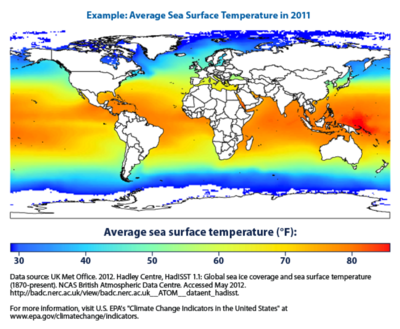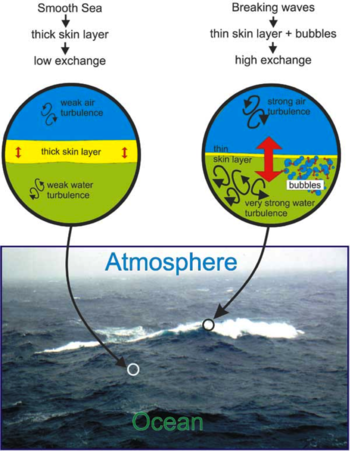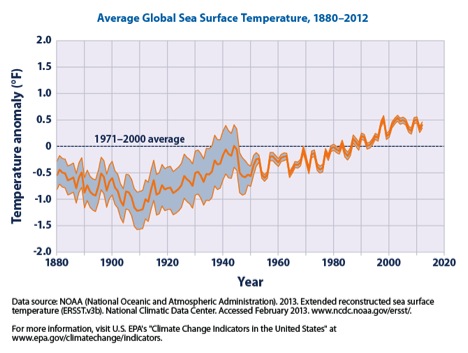SSTs: Difference between revisions
From coraldigest
| Line 41: | Line 41: | ||
**Even an increase of 1.5 degrees Celsius global mean warming suggests 89% of coral reef ecosystems would face long-term degradation without a change in thermal tolerance | **Even an increase of 1.5 degrees Celsius global mean warming suggests 89% of coral reef ecosystems would face long-term degradation without a change in thermal tolerance | ||
**To protect at least 50% of the coral reef cells, global mean temperature change would have to be limited to 1.2 degrees Celsius global mean warming | **To protect at least 50% of the coral reef cells, global mean temperature change would have to be limited to 1.2 degrees Celsius global mean warming | ||
**thermal stress | **thermal stress <ref>Frieler, K., M. Meinshausen, A. Golly, M. Mengel, K. Lebek, S. D. Donner, and O. Hoegh-Guldberg. "Limiting Global Warming to 2 °C Is Unlikely to save Most Coral Reefs." Nature Climate Change 3.2 (2012): 165-70. Web. </ref> | ||
== Notes == | == Notes == | ||
<references /> | <references /> | ||
Revision as of 22:31, 15 April 2014
Sea Surface Temperatures (SSTs)
What are Sea Surface Temperatures (SST) and how are they measured?

- Sea Surface Temperature is a measure of the energy created by motion of the water molecules at the top layer of the ocean also known as the near-surface layer.[1] SSTs vary primarily with latitude but other factors can also affect it. Temperatures are measured between 10 micrometers with infrared bands and 1 millimeter below the surface with microwave bands using a radiometer.Historically before the 1980s, SST was measured with instruments on shorelines, ships, and buoys, however this was not the most precise or accurate measure.Currently the bulk of SSTs is measured by remote sensing from satellites measuring electromagnetic radiation produced by motion of the charged particle. The motion of the charged particle produces electromagnetic radiation and the amplitude of the infrared and microwave wavelengths vary with temperature, this is sensed by the satellites and recorded.There are still some floating instruments in the ocean that measure temperature.
Why and how are Sea Surface Temperatures rising?
- Natural
- Absorbs heat and radiation from the atmosphere

- Dominant atmospheric factors driving ocean temperature include wind speed, air temperature, cloudiness, and humidity; dominant oceanic factors include heat transport by currents and vertical mixing. Fluctuations in sea surface temperatures vary with the seasons.
- Absorbs heat and radiation from the atmosphere
- Anthropogenic
- Warming as a direct result of increased concentration of carbon dioxide in the atmosphere that raises air temperatures
- Feedback Loops
- Relationship between ocean-atmosphere heat exchanges and global weather and climate patterns
- In the case of thermal expansion, given an equal mass, the total volume of ocean waters decrease when ocean temperatures drop and expand when temperatures increase
- Positive Feedback: warming of sea surface temperatures leads to increased ice melting and evaporation and increased humidity creates more intense storms, more extreme precipitation, and wind events. Some areas because of increased evaporation will experience intense surface drying increasing the risk of flooding when intense storms occur. The Potential Link Between Sea Surface Temperatures and Flooding
What impact does this have on Coral Reefs?
- Coral bleaching is a stress response that causes the coral to expel their zooxanthellae or lose algal pigmentation
- Bleaching can be triggered when thermal condition is as little as 1 C higher than mean summer maximum. [2] Evidence emerging of possible thermal thresholds in the range of 30-32 C for some physiological processes of coral reef organisms [3]
- From June to October 2005, satellite-based sea surface temperature (SST) observations from the U.S. National Oceanic and Atmospheric Administration (NOAA) detected a large region of warming ocean temperatures that reached a maximum anomaly of +1.2°C vs. the long-term mean when averaged across all Caribbean reef sites.
- Mortality exceeded 50% in several locations
- Increased temperatures were quickly followed by a loss of resistance to pathogenic disease and an increased abundance of microbial pathogens [4]
- Increased flooding of nutrients and sediments
- Sediment and nutrient loads may occur as chronic long term loads and short term pulses such as river flood plumes, related to storm events
- Can lead to phase shifts on the coral reefs
What are some things we can do to slow down rising Sea Surface Temperatures and their effects?
- Reduce Carbon Emissions and pollutants
- Increase protection for coral to mitigate other threats and make it less vulnerable
- Lower the amount of nutrient overloading
- Increase vegetation cover to prevent sediment runoff
What are some predictions in the scientific community in response to current trends?
- Scientific Study in Japan: Rapid poleward range expansion of tropical reef corals in response to rising sea surface temperatures
- Speed of coral range expansions presented in this study reached up to 14 km/year which is far greater than that of other species and greater than other marine 5km/year typically
- Poleward current flows only… increases speed of coral reef expansion [5]
- Second Study: Limiting global warming to 2 degrees Celsius is unlikely to save most coral reefs
- An increase of 2 degrees Celsius global mean warming would result in a long-term degradation of all coral reef ecosystems without a change in thermal tolerance
- Even an increase of 1.5 degrees Celsius global mean warming suggests 89% of coral reef ecosystems would face long-term degradation without a change in thermal tolerance
- To protect at least 50% of the coral reef cells, global mean temperature change would have to be limited to 1.2 degrees Celsius global mean warming
- thermal stress [6]
Notes
- ↑ Sea Surface Temperature. NASA, n.d. Web. 15 Apr. 2014. http://podaac.jpl.nasa.gov/SeaSurfaceTemperature
- ↑ Peñaflor, E. L., W. J. Skirving, A. E. Strong, S. F. Heron, and L. T. David. "Sea-surface Temperature and Thermal Stress in the Coral Triangle over the past Two Decades." Coral Reefs 28.4 (2009): 841-50. Web.
- ↑ Lough, J. M. "Small Change, Big Difference: Sea Surface Temperature Distributions for Tropical Coral Reef Ecosystems, 1950–2011." Journal of Geophysical Research 117.C9 (2012): n. pag. Web.
- ↑ Eakin, C. Mark, Jessica A. Morgan, Scott F. Heron, Tyler B. Smith, Gang Liu, Lorenzo Alvarez-Filip, Bart Baca, Erich Bartels, Carolina Bastidas, Claude Bouchon, Marilyn Brandt, Andrew W. Bruckner, Lucy Bunkley-Williams, Andrew Cameron, Billy D. Causey, Mark Chiappone, Tyler R. L. Christensen, M. James C Crabbe, Owen Day, Elena De La Guardia, Guillermo Díaz-Pulido, Daniel Diresta, Diego L. Gil-Agudelo, David S. Gilliam, Robert N. Ginsburg, Shannon Gore, Héctor M. Guzmán, James C. Hendee, Edwin A. Hernández-Delgado, Ellen Husain, Christopher F. G. Jeffrey, Ross J. Jones, Eric Jordán-Dahlgren, Les S. Kaufman, David I. Kline, Philip A. Kramer, Judith C. Lang, Diego Lirman, Jennie Mallela, Carrie Manfrino, Jean-Philippe Maréchal, Ken Marks, Jennifer Mihaly, W. Jeff Miller, Erich M. Mueller, Erinn M. Muller, Carlos A. Orozco Toro, Hazel A. Oxenford, Daniel Ponce-Taylor, Norman Quinn, Kim B. Ritchie, Sebastián Rodríguez, Alberto Rodríguez Ramírez, Sandra Romano, Jameal F. Samhouri, Juan A. Sánchez, George P. Schmahl, Burton V. Shank, William J. Skirving, Sascha C. C. Steiner, Estrella Villamizar, Sheila M. Walsh, Cory Walter, Ernesto Weil, Ernest H. Williams, Kimberly Woody Roberson, and Yusri Yusuf. "Caribbean Corals in Crisis: Record Thermal Stress, Bleaching, and Mortality in 2005." Ed. Tamara Natasha Romanuk. PLoS ONE 5.11 (2010): Web.
- ↑ Yamano, Hiroya, Kaoru Sugihara, and Keiichi Nomura. "Rapid Poleward Range Expansion of Tropical Reef Corals in Response to Rising Sea Surface Temperatures." Geophysical Research Letters 38.4 (2011): Web.
- ↑ Frieler, K., M. Meinshausen, A. Golly, M. Mengel, K. Lebek, S. D. Donner, and O. Hoegh-Guldberg. "Limiting Global Warming to 2 °C Is Unlikely to save Most Coral Reefs." Nature Climate Change 3.2 (2012): 165-70. Web.
